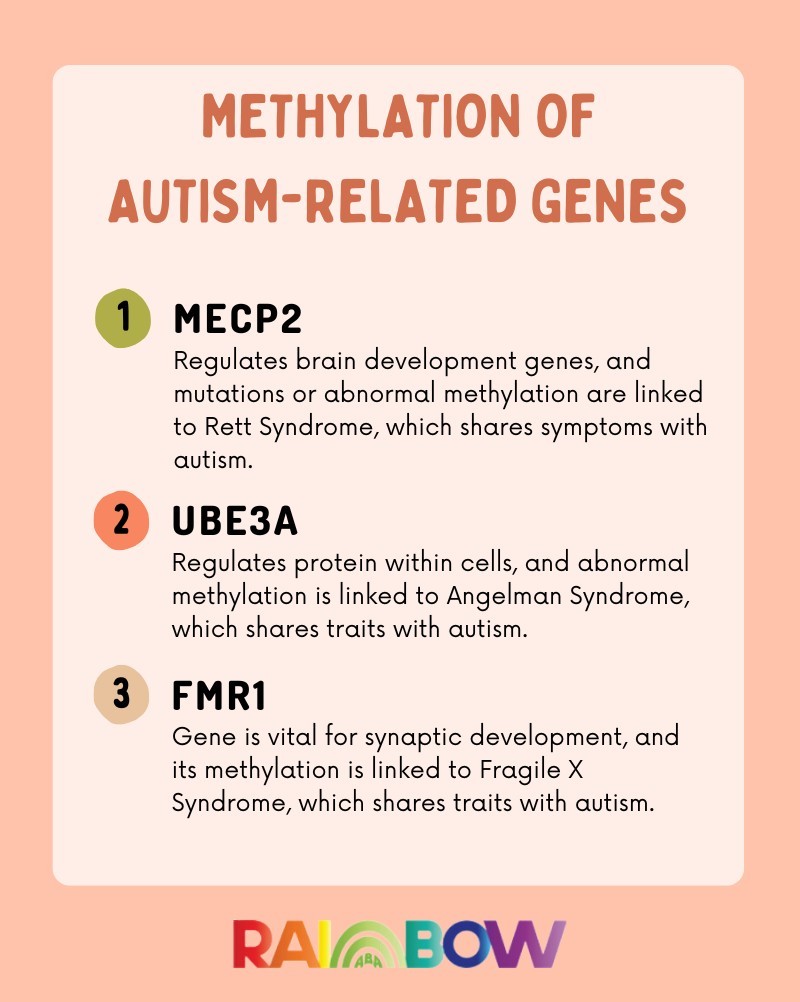Autism Spectrum Disorder (ASD) is a complex neurodevelopmental condition that affects individuals in a variety of ways. While the precise causes of autism remain unclear, research is increasingly exploring the role of genetics and epigenetics in its development. One key aspect of epigenetics that has been linked to autism is methylation, a process that can alter gene expression without changing the underlying genetic code.
What is Methylation?
Methylation is a biochemical process that involves the addition of a methyl group (CH3) to the DNA molecule. This modification typically occurs on the cytosine base of a CpG dinucleotide, which is a common sequence in DNA. In individuals with autism, methylation doesn’t change the genetic sequence itself but affects how genes are expressed. This means that some genes can be silenced or activated depending on the methylation marks they carry.
In a healthy individual, methylation patterns are carefully regulated, ensuring that genes are activated or silenced at appropriate times. However, in individuals with autism, these methylation patterns may be disrupted, potentially affecting brain development and behavior. By understanding how methylation works, we can better understand its role in autism and how it may contribute to the symptoms of the condition.
How Methylation Affects Gene Expression
Gene expression refers to the process by which information from a gene is used to create proteins, which are essential for the body’s functions. Methylation can influence gene expression in two ways: by silencing a gene or by activating it.
When a methyl group is added to a gene, it can prevent the necessary cellular machinery from accessing and reading the gene, effectively silencing it. On the other hand, if methylation marks are removed, a previously silenced gene can become active again. This dynamic regulation of gene expression plays a critical role in development and overall health.
In the case of autism, abnormal methylation patterns in genes related to brain development, neuronal function, and synaptic plasticity have been identified. These changes may contribute to the characteristic behaviors and developmental delays associated with the disorder, highlighting the importance of understanding methylation in autism.
The Role of Methylation in Autism: What the Research Shows
Many aspects of the relationship between methylation and autism remain unclear. Yet, several key findings have emerged regarding how methylation may influence the development of autism. Findings suggest that methylation plays a significant role in regulating genes that are important for brain development and function.
Methylation of Autism-Related Genes
Several genes involved in neurodevelopment and synaptic functioning have been found to exhibit abnormal methylation patterns in individuals with autism. Some of the most studied genes in this context include MECP2, UBE3A, and FMR1.

These genes, and their abnormal methylation patterns, may help explain some of the neurodevelopmental challenges faced by children with autism.
Abnormal Methylation Patterns in Brain Regions
Many brain regions are also involved in critical functions such as social behavior, communication, and sensory processing. Notably, the prefrontal cortex, amygdala, and cerebellum have all been identified as regions where methylation alterations may contribute to autism.
- Prefrontal Cortex: This brain region is responsible for higher cognitive functions like decision-making and social behavior. Abnormal methylation patterns in the prefrontal cortex have been found in individuals with autism.
- Amygdala: Involved in emotional processing, the amygdala also shows altered methylation in certain autism subtypes. This could affect emotional regulation and response to social cues.
- Cerebellum: The cerebellum is responsible for motor coordination and sensory processing. Methylation abnormalities in this area may contribute to the sensory sensitivities and motor difficulties often observed in children with autism.
These findings suggest that abnormal methylation may be responsible for the brain changes that contribute to the behaviors and challenges seen in autism.
Potential Interventions: Can Methylation Be Reversed?
Because methylation is a reversible process, there is growing interest in the possibility of interventions that could alter methylation patterns and improve outcomes for individuals with autism. While much of the research is still in its early stages, some promising areas are being explored.
Diet and Nutritional Interventions
Certain nutrients are essential for proper methylation processes, and deficiencies in these nutrients can lead to altered methylation patterns. For example, folate, vitamin B12, and choline are critical for maintaining healthy methylation. Some studies suggest that supplementing these nutrients may help regulate methylation and improve neurodevelopmental outcomes in children with autism.

- Folate and B vitamins: These vitamins are essential for the one-carbon metabolism pathway, which supports normal methylation. Some studies suggest that folic acid supplementation during pregnancy may reduce the risk of autism, though evidence is still inconclusive.
- Choline: Choline is important for brain development and has been linked to methylation regulation. Animal studies have shown that choline supplementation during pregnancy may influence genes involved in neurodevelopment, potentially reducing autism risk.
Pharmacological Interventions
Researchers are exploring drugs that could target enzymes involved in methylation, such as DNA methyltransferase inhibitors (DNMT inhibitors). These drugs may help modulate DNA methylation and could be potential therapies for neurodevelopmental disorders. However, these treatments are still in the early stages, and much more research is needed to determine their safety and effectiveness.
Behavioral and Environmental Interventions
In addition to pharmacological approaches, existing behavioral and environmental therapies may also play a role in modulating methylation indirectly. Early intervention therapies, including applied behavior analysis (ABA), have been shown to improve outcomes for children with autism. These therapies may influence gene expression and brain development over time, potentially contributing to better long-term outcomes.
Exploring Methylation’s Impact on Autism
The relationship between methylation and autism is a fascinating area of research that may offer insights into the underlying causes of the condition. While much is still unknown, studies have shown that abnormal methylation patterns are present in several autism-related genes and brain regions. As research continues to advance, methylation-based interventions may become an important part of autism treatment strategies.
If you’re seeking guidance from a trusted ABA therapist in New Jersey, Texas, or Georgia, Rainbow ABA can help. Our team offers tailored ABA therapy programs designed to support your child’s unique needs and foster growth. Contact us today to learn how we can help create the best plan for your child’s development!
Sources:



